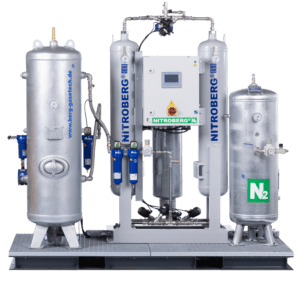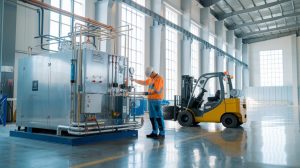Nitrogen generators play a vital role in various industries by providing a continuous supply of high-purity nitrogen gas. This comprehensive guide covers the working principles of PSA and membrane nitrogen generators, their installation, operational guidelines, and maintenance practices.
Additionally, it addresses the safety precautions, risks, nitrogen production capacity, life expectancy, and ventilation requirements. Understanding these aspects ensures the optimal performance and safe usage of nitrogen generators.
What is a Nitrogen Generator and Why is it Important?
A nitrogen generator is a device that separates nitrogen gas from atmospheric air, offering a steady supply of high-purity nitrogen for numerous industrial applications. Its importance lies in its ability to produce nitrogen on-site, which reduces dependency on external suppliers, lowers costs, and ensures a consistent supply.
Nitrogen is crucial in food packaging, electronics manufacturing, and chemical processing to create inert atmospheres, prevent oxidation, and maintain product quality.
How Does a Nitrogen Generator Work?
Nitrogen generation is a critical process facilitated by various nitrogen generation systems, such as PSA nitrogen generators and membrane nitrogen generators. Understanding how does a nitrogen generator work involves exploring the mechanisms behind the separation of nitrogen gas from the ambient air.
PSA nitrogen generators work using pressure swing adsorption (PSA), where compressed air streams pass through carbon molecular sieve (CMS) beds. These sieves adsorb oxygen molecules, water vapor, and trace gases, allowing nitrogen gas to flow through as an inert gas. The CMS then releases the adsorbed gases as exhaust gas during the desorption phase.
In contrast, membrane nitrogen generation technology uses a compressed air stream passing through polymer membranes to separate nitrogen molecules from other gas molecules. Both methods ensure that the nitrogen produced is of high purity, meeting the demands of chemical industries and other applications that require reliable on-site nitrogen generators.
What is the Membrane Separation Technology?
Membrane nitrogen generators use compressed air passed through hollow fibers made of polymer membranes. These membranes selectively allow nitrogen molecules to pass while retaining oxygen, water vapor, and other gases.
The separation process is driven by partial pressure differences across the membrane, resulting in a continuous stream of high-purity nitrogen. The compressed air, rich in oxygen molecules and other impurities, is fed into the membrane module where selective permeation occurs.
Oxygen molecules and other unwanted gases are effectively filtered out, allowing only nitrogen gas to pass through, resulting in a high-purity nitrogen output.
What are the Key Components of a Nitrogen Generator?
- Air Compressor: Provides compressed air for the separation process.
- Filters and Dryer: Remove contaminants from compressed air, including oil, water vapor, and particulate matter, ensuring that the air entering the generator is clean and dry.
- Adsorption Towers: Contain CMS or membranes for gas separation, crucial for the PSA process.
- Control System: Manages the switching between adsorption and desorption phases in PSA systems.
- Buffer Tank: Stores produced nitrogen gas.
How Do You Install a Nitrogen Generator?
Installation involves:
- Site Assessment: Ensure space, ventilation, and power supply.
- Positioning: Place the generator on a stable surface.
- Connection: Connect the air compressor, filtration units, and nitrogen generator.
- Ventilation Setup: Ensure proper ventilation for exhaust gases.
- Testing: Perform tests to check for leaks and system performance.
What are the Operational Guidelines for Using a Nitrogen Generator?
- Start-Up: Follow manufacturer instructions, including pre-use checks and warm-up procedures.
- Monitoring: Regularly monitor pressure levels, flow rates, and nitrogen purity.
- Maintenance: Adhere to maintenance routines to replace filters, inspect CMS, and check for wear and tear.
- Safety: Ensure proper ventilation and follow safety protocols.
How Do You Maintain a Nitrogen Generator for Optimal Performance?
- Regular Inspections: Detect issues early.
- Filter Replacement: Maintain air quality.
- CMS Regeneration: Ensure proper desorption cycles for PSA systems.
- Leak Checks: Regularly check for air leaks.
- Software Updates: Keep control system software updated.
What are the Safety Precautions When Using Nitrogen Generators?
- Ventilation Requirements: Ensure adequate airflow to disperse exhaust gases.
- Pressure Handling: Handle high-pressure components with care.
- Emergency Procedures: Establish emergency shutdown procedures.
- Personal Protective Equipment: Use appropriate PPE during maintenance.
What are the Common Applications of Nitrogen Generators?
- Food Packaging: Prevents oxidation and extends shelf life.
- Electronics Manufacturing: Provides an inert atmosphere to prevent corrosion.
- Chemical Processing: Used in inerting and purging to prevent reactions with oxygen.
- Pharmaceuticals: Ensures high purity environments for drug manufacturing.
What are the Advantages of On-Site Nitrogen Generation?
- Cost Savings: Reduces costs of purchasing and transporting liquid nitrogen. Learn more about the investment in nitrogen generators.
- Continuous Production: Ensures a reliable supply of nitrogen tailored to specific purity and flow rate needs.
- Environmental Impact: Minimizes carbon footprint by reducing transportation and storage needs.
- Flexibility: Allows customization of nitrogen purity and quantity based on application needs.
What are the Risks of Nitrogen Generators?
While nitrogen generators are highly beneficial, they come with certain risks:
- Asphyxiation: Nitrogen is an inert gas and can displace oxygen in enclosed spaces, posing a risk of asphyxiation.
- High Pressure: Handling high-pressure systems requires caution to prevent accidents.
- Maintenance Hazards: Regular maintenance involves handling components that can pose safety risks if not properly managed.
What is the Life Expectancy of a Nitrogen Generator?
The life expectancy of a nitrogen generator depends on the type, usage, and maintenance. Typically, nitrogen generators have a lifespan of 10-15 years with proper maintenance, while membrane nitrogen generators can last 5-10 years. Regular maintenance and adherence to manufacturer guidelines can extend the lifespan of the equipment.
How Much Nitrogen Can a PSA Nitrogen Generator Produce?
The amount of nitrogen a generator can produce varies based on the model and technology used. Nitrogen generators and membrane nitrogen generators can produce anywhere from a few cubic meters per hour to several thousand cubic meters per hour, depending on the system’s design and application requirements.
What are the Ventilation Requirements for Nitrogen Generators?
Proper ventilation is crucial for the safe operation of nitrogen generators. Ensure that the installation area has adequate airflow to disperse exhaust gases and prevent the buildup of nitrogen, which can displace oxygen and create a hazardous environment. Ventilation systems should comply with local safety regulations and manufacturer recommendations.
Contact Us
For more information about nitrogen generators and how they can benefit your operations, please contact Berg-Gasetech. Our experts are ready to assist you with your nitrogen generation needs, providing detailed information, installation guidance, and maintenance support to ensure optimal performance and safety.
Reach out to us, and let us help you achieve cost-effective and reliable nitrogen production on-site.




